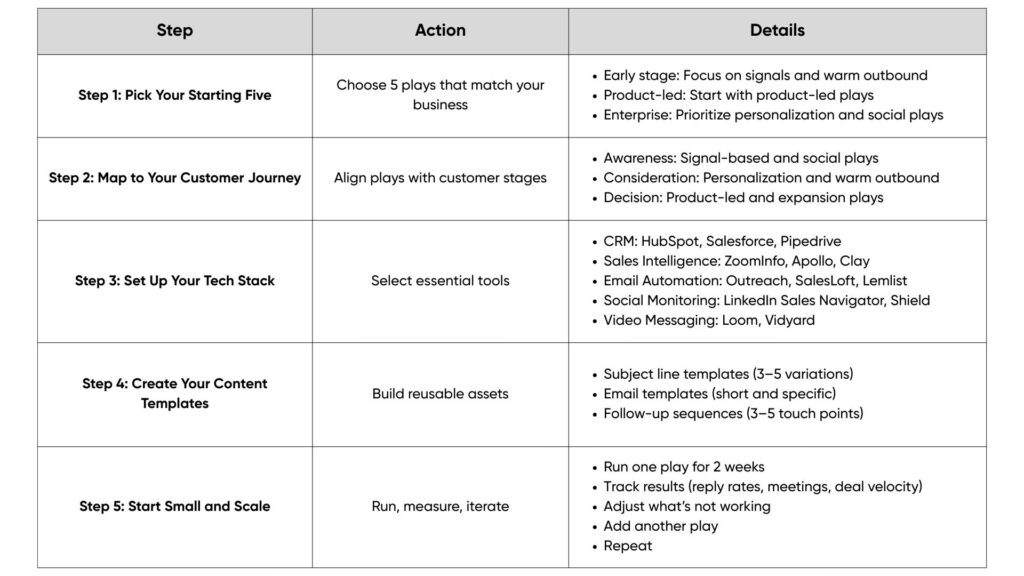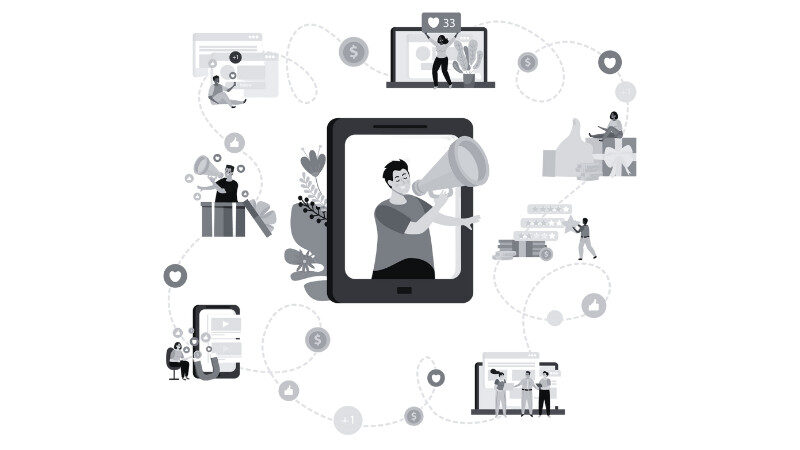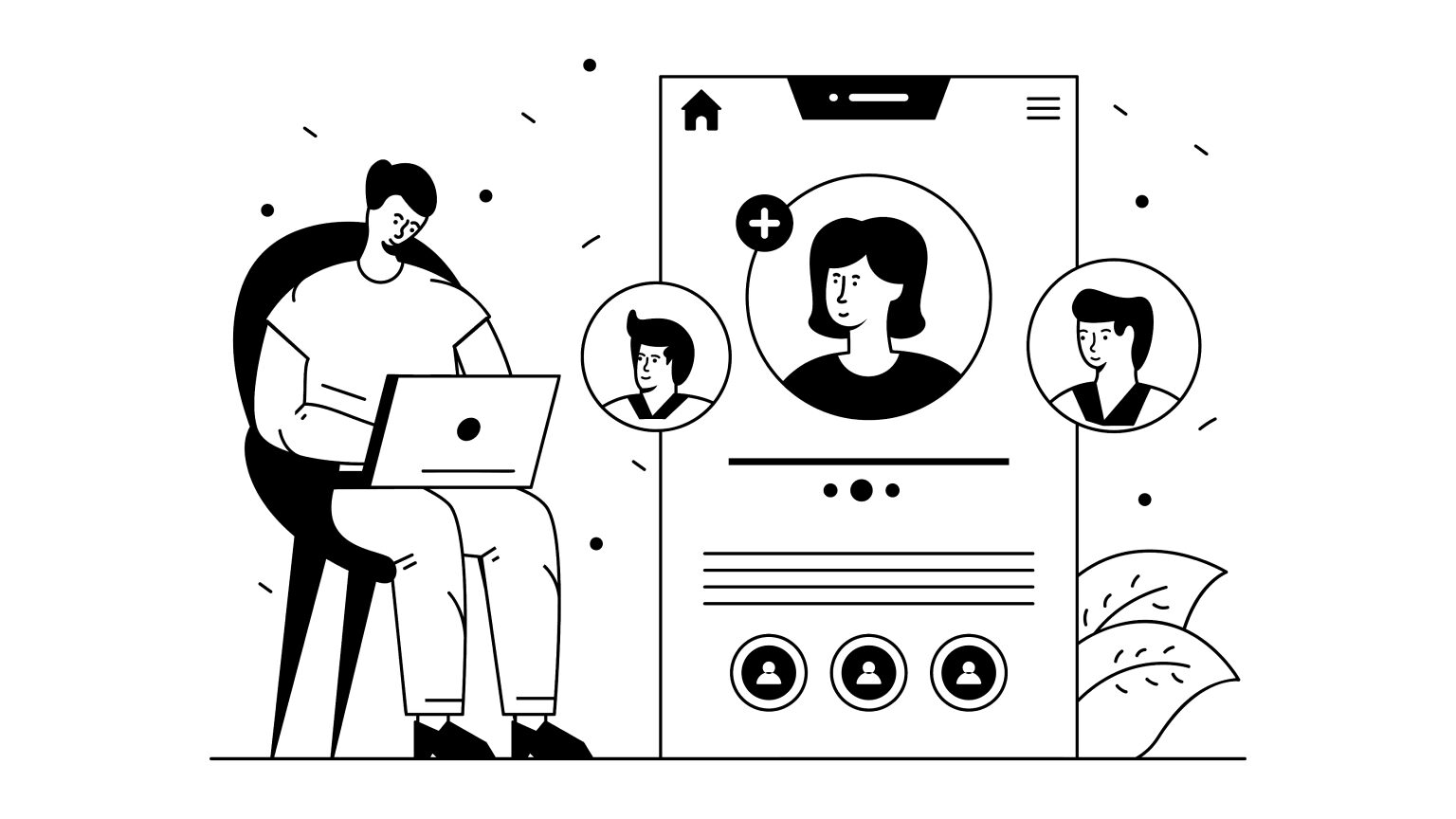Most startup marketing is expensive guesswork—blasting emails, chasing leads, hoping for virality. The real winners build smart GTM systems that intercept buying signals and start meaningful conversations at the right time. This guide gives you 25 proven plays (signal-based, outbound, personalized, social, product-led and expansion) plus a 5-step implementation framework to set up a predictable revenue engine that runs while you sleep
Tired of trying to generate leads? Then don’t. The top brands don’t generate leads, they intercept buying signals.
Picture this: A prospect visits your website, checks your pricing, then gets a perfectly timed email that feels like you’re reading their mind. That’s not luck – that’s systematic revenue generation.”
But here’s the thing about most startup marketing: it’s basically expensive guesswork.
You buy some email lists, blast out messages to strangers and hope something sticks. Maybe you get lucky with a viral LinkedIn post. Maybe you don’t.
But the companies that are actually crushing it? They’ve built what we call “smart GTM systems” – automated plays that find the right people at the perfect moment and start conversations that actually matter.
Here are 25 proven plays that can transform your go-to-market from random acts of marketing into a predictable revenue engine.
Table of Contents
TogglePart 1: Signal-Based Plays
These are your early warning system, telling you when someone’s ready to buy.
1. Website Visitor Follow-Up
What it is: When someone visits your website, you automatically reach out within 24 hours.
Why it works: They already know who you are, you’re not cold calling anymore.
How to set it up: Use tools like Clearbit or ZoomInfo to identify visitors, then trigger a personalized email sequence.
Example message: “Hi Sarah, I noticed someone from X Corp was checking out our pricing page yesterday. Was that you? Happy to answer any questions about how we help companies like yours cut project timelines in half.”
2. Tech Stack Monitoring
What it is: You watch when companies start using (or stop using) specific tools, then reach out with a better alternative.
Why it works: Timing is everything. Catch them during a change, not after they’ve settled.
How to set it up: Tools like BuiltWith or Datanyze can alert you when prospects add or remove technologies.
3. Competitor Use Case Hijacking
What it is: When you see a competitor’s customer using their solution in a way you do better, you reach out.
Why it works: They’re already doing the thing, just not optimally.
How to set it up: Monitor competitor case studies and LinkedIn posts about implementations.
4. Lookalike Winner Campaigns
What it is: Find companies that look exactly like your recent successful customers.
Why it works: If it worked for Company A, it’ll probably work for their twin.
How to set it up: Export your best customers’ firmographics, then use that criteria to find similar companies.
5. LinkedIn Activity Targeting
What it is: Target companies whose employees are engaging with content related to your solution.
Why it works: Engagement shows interest and intent.
How to set it up: Monitor who likes and comments on industry content, then target their companies.
6. Boss Switch Campaigns
What it is: When someone you know gets promoted or changes jobs, you reach out to their old boss.
Why it works: People hire people they know and trust.
How to set it up: Set up LinkedIn alerts for job changes in your network.
Example message: “Hi John, I saw that Smith moved to a new role. He was telling me how much your team loved working with data visualization tools. Mind if I share something that might be relevant for your next hire?”
7. Job Posting Signals
What it is: Companies posting jobs in your space are usually investing in that area.
Why it works: They’re literally advertising their intent to spend money.
How to set it up: Set up alerts on job boards for relevant keywords, then reach out to hiring managers.
8. Event-Based Timing
What it is: Use current events, sports or industry happenings as conversation starters.
Why it works: Timely, relevant, and shows you’re paying attention.
How to set it up: Create email templates for different types of events and trigger them based on news or calendar events.
Part 2: Warm Outbound Plays
These aren’t cold emails, they’re continuing conversations.
9. Ghost Prospect Revival
What it is: Re-engage people who showed interest but went quiet.
Why it works: Timing might have been wrong before, but circumstances change.
How to set it up: Set up automated sequences that trigger 3, 6 and 12 months after someone goes cold.
Example message: “Hi John, we spoke about your team’s workflow challenges back in March. I know the timing wasn’t right then, but wanted to share something new that might be perfect for where you are now…”
10. Closed-Lost Callbacks
What it is: Systematically re-engage deals you lost, with context about why they didn’t choose you.
Why it works: Shows you remember them and have been thinking about their specific situation.
How to set it up: Tag lost deals with the reason, then trigger follow-ups based on common resolution timeframes.
11. Champion Reunion
What it is: When someone who loved your product moves to a new company, you follow up.
Why it works: They already know your value and have influence at their new place.
How to set it up: Monitor LinkedIn for job changes among your champions.
12. Champion’s Network Play
What it is: Ask your champions for warm intros to companies they used to work for.
Why it works: Warm introductions convert 5x better than cold outreach.
How to set it up: Quarterly outreach to champions asking about their previous companies.
13. Investor Connection Play
What it is: Reach out to companies that share investors with your existing customers.
Why it works: Mutual connections create implied trust and credibility.
How to set it up: Map your customers’ investors and target their other portfolio companies.
14. Customer Alumni Network
What it is: When you land a big customer, reach out to people who used to work there.
Why it works: They know the company’s pain points and your solution’s value.
How to set it up: Use LinkedIn to find former employees of new customers, then reach out within 30 days of signing.
Part 3: Personalization Plays
No, just “Hi [First Name]” isn’t actually personal.
15. Pre-Call Intelligence Briefing
What it is: Automatically research and brief your team before every call.
Why it works: You sound smart and prepared, which builds instant credibility.
How to set it up: Create automated reports pulling recent news, funding, product launches and leadership changes.
16. Account-Specific Landing Pages
What it is: Create custom landing pages for your biggest prospects.
Why it works: Shows serious intent and investment in the relationship.
How to set it up: Use tools like Unbounce or HubSpot to create dynamic pages that populate with company-specific information.
17. One-to-One Video Messages
What it is: Send personalized video messages instead of text emails.
Why it works: Video feels more personal and gets higher response rates.
How to set it up: Use Loom or Vidyard to record quick, personalized videos for high-value prospects.
Part 4: Social Media Plays
Social platforms can work as revenue engines.
18. Content Engagement Campaigns
What it is: Reference something specific the prospect posted or engaged with on LinkedIn.
Why it works: Shows you’re actually paying attention, not just blasting messages.
How to set it up: Monitor your prospects’ LinkedIn activity and reference their posts in your outreach.
Example message: “Loved your post about the challenges of remote team coordination, John. We actually help teams solve exactly that problem – mind if I share how Company X cut their meeting time by 60%?”
19. Influencer Network Targeting
What it is: Find people who engage with industry influencers or your customers’ content.
Why it works: If they’re following the conversation, they’re probably interested in the solution.
How to set it up: Use tools like Shield or SalesNavigator to find engaged audiences around relevant content.
Part 5: Product-Led Plays
Let your product create sales opportunities.
20. Domain Roll-Up Campaigns
What it is: When multiple people from the same company use your free product, reach out to the decision-maker.
Why it works: Shows organic adoption and removes the “will this work?” question.
How to set it up: Set up alerts when 2+ users from the same domain sign up.
Example message: “Hi John, I noticed three people from X Corp are using our tool. Thought you might want to know about our team features that could help you coordinate their work better.”
21. Expansion Trigger Play
What it is: Automatically reach out when existing users start inviting teammates.
Why it works: Shows growing interest and usage within the organization.
How to set it up: Track invitation patterns and trigger outreach when usage spreads.
22. Admin Activation Campaign
What it is: When admin users aren’t engaging during trial periods, run targeted re-engagement.
Why it works: Inactive admins usually mean stalled trials and lost deals.
How to set it up: Monitor admin login frequency and trigger helpful content when they go quiet.
23. “Aha Moment” Reinforcement
What it is: Reach out when users hit key milestones or visit important pages like pricing.
Why it works: They’re showing buying intent through their actions.
How to set it up: Set up behavioral triggers in your product analytics tool.
Part 6: Expansion Plays
Turn customers into bigger customers.
24. Usage Spike Alerts
What it is: Automatically reach out when accounts hit usage limits or show expansion signals.
Why it works: They’re already getting value and hitting natural upgrade points.
How to set it up: Set up automated alerts when accounts reach 80% of their limits.
Example message: “Hi John, I see your team is getting great value from the platform – you’re already using 85% of your monthly quota. Want to chat about options that won’t slow down your momentum?”
25. Feature Discovery Campaigns
What it is: Trigger upgrade conversations when free users start exploring paid features.
Why it works: They’re literally telling you what they want to buy.
How to set it up: Track feature usage and trigger targeted campaigns when users interact with premium features.
How to Actually Implement This Stuff
This might seem like a lot, but thankfully, you don’t need to do all 25 plays tomorrow. Start with these steps:

The Bottom Line
Most companies fail at go-to-market because they’re playing checkers while their competitors are playing chess.
These plays turn you into a chess player. They help you think three moves ahead, spot opportunities others miss and build relationships instead of just sending messages.
Once you set them up, they run automatically. You’re literally building a revenue machine that works while you focus on other important stuff.
But remember, tools don’t create results, systems do. Pick the plays that make sense for your business, set them up properly and then optimize them over time.
Your future self (and your bank account) will thank you.
Want help implementing these plays for your business? The systems and processes are only as good as the strategy behind them. Sometimes you need someone who’s done this before to help you avoid the common pitfalls and get to results faster.
About The Wise Idiot
We’re The Wise Idiot, and yes, that’s really our name. We’re a content marketing agency that’s been helping startups and growing brands tell their stories since 2017.
Here’s what we do: we take the stuff that makes your business special and turn it into content that actually works. Whether that’s writing that doesn’t put people to sleep, websites that make visitors stick around, or social media that gets people talking, we handle it all.
FAQs
Q1. What are GTM plays?
GTM plays are structured marketing and sales actions designed to target prospects at the right moment with the right message. So instead of random outreach, you use signals, personalization, and automation to drive predictable growth.
Q2. Which GTM plays are best for early-stage startups?
Early-stage startups should start with signal-based plays (like job postings or website visitor follow-ups) and warm outbound plays (like ghost prospect revival), since these generate faster, warmer leads.
Q3. Do I need expensive tools to set up these GTM systems?
Not necessarily. A basic stack with a CRM (like HubSpot), email automation (like Outreach), and LinkedIn monitoring can get you started. You can scale your tools as you grow.
Q4. How do I know which GTM plays will work for my business?
Match plays to your customer journey and business model. For example, product-led companies should prioritize product-led plays, while enterprise-focused companies should invest in personalization and social plays.







